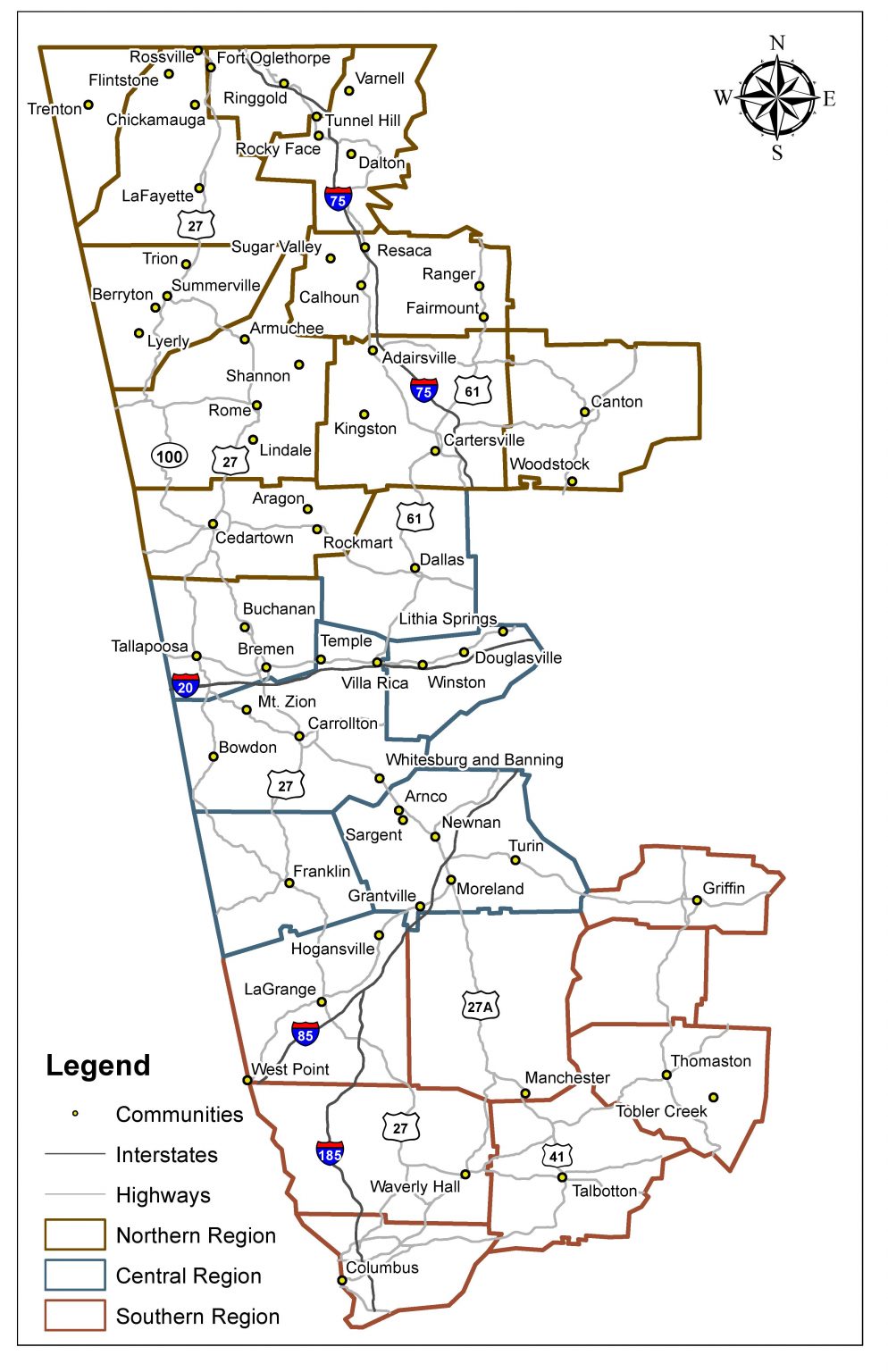The textile industry quickly followed the arrival of the railroad, which allowed the mills to ship goods in and out of town, in this small southern community.
As with many other communities, Douglasville saw a rise in industry roll in with the new railroads. The first textile mill, New Eden Mill, was established here in 1895; it soon burned down, was rebuilt, and eventually reopened as Lois Mill. This mill featured an innovative design that allowed for more windows which, in turn, allowed for more light and better ventilation for mill workers.
Visit
Things to Do
- Douglas County Museum of History and Art, 12431 East Veterans Memorial Highway: This museum is located in the historic Douglas County Courthouse and houses an archive of local history. The new Douglas County Courthouse was opened in 1998, leaving this location destined for sale and disposal; however, the Douglas County Tourism and History Commission persuaded the saving of this location. Their hours of operation are Tuesday through Friday 10:00 am – 5:00 pm and Saturday 10:00 am – 3:00 pm.
- Mill Village Park, 8320 Grady Street: This city park is on property that was once a part of Lois Mil and Beaver Mills mill village. The 3-acre park features an outdoor basketball court, a pavilion, playground equipment, grills, and picnic tables.
Places to See
The following properties are not open to the public, but you can view them from the exterior to learn more about the buildings that supported the textile industry here.
- Lois Mill Village, 12171 GA-5: The Lois Mill/Beaver Mills building is no longer standing, and the homes in this area are private and not accessible to the public. However, you can still drive through the mill village, located east of downtown Douglasville near Fairburn Road (Highway 92).
- Douglasville Knitting Mill Village: The Douglasville Knitting Mill was required to build houses to shelter their employees. A handful of those houses remain across Highway 92 from the mill site.
History

Douglasville, established in 1870, like many postbellum Georgia towns soon saw industry and commerce arrive with the railroad. The city’s textile industry flourished with the construction of the Georgia Western Railroad from Atlanta to Birmingham in 1883, which passed through Douglasville. Mills, plants, and shops were built along the rail line, including cotton mills New Eden Mill and Douglas Knitting Mill.
Constructed in 1895, New Eden Mill was Douglasville’s first textile operation; however, the new mill burned soon after completion. Reconstruction of the cotton mill began in January of 1898. Ownership was unstable during the construction with a series of buyouts and the business was known as Georgia Western Cotton Mill and New Century Cotton Mill over the next decade. The completed cotton mill reopened in 1908 as Lois Mill.

Lois Cotton Mill featured an innovative industrial design by Charles Paray. The mill’s external walls were comprised of alternating ridged and grooved walls sometimes described as “zigzag” walls. The design allowed many windows in the exterior walls, providing better lighting and ventilation for mill workers. The building also incorporated two foundations for easier repair in case of fire. Lois Mill produced printed cloth in its early years, manufactured on 20,000 ring spindles and 500 looms. The company established a mill village for the workers, including small frame houses along Grady and Copper Streets, now home to Mill Village Park.
By the 1930s, Beaver Mills of Massachusetts purchased Lois Cotton Mill, and the company became part of Beaver’s broad network of cotton manufacturing across the South. Each week workers used 75 bales of cotton to produce over 17 tons of cotton products including broadcloth, a type of clothing fabric. The company shipped 90% of the cloth produced in Douglasville to other Beaver Mills locations outside Georgia for finishing and sold the final products through a New York company.
Employees in Beaver-Lois Mill unionized in 1933 with the United Textile Workers of America. Many of those workers participated in the General Textile Strike of 1934, which closed the mill for four weeks. The strike proved unsuccessful for employees, but continued union efforts led to the closing of the mill again in 1935. When it reopened, workers faced lower wages and increased workloads, leading to continued labor unrest through the 1940s. The mill closed and sat empty for many years before it burned in 2012.
Douglasville’s textile history is remembered today through the commerce it brought to its community. Like many communities along the trail, textile-manufacturing companies wove their way into communities due to the railroad. Georgia Western Railroad aided this community by shipping cotton and cloth in and out to communities all over Georgia and into major markets. Lois Mill sold some of their goods to Gilreath Manufacturing Company who used Lois Mill cloth to produce coats. Along the trail, you will find many stories of how textiles influenced each community but Douglasville’s textile history is unique because of its innovative textile manufacturing structure, Lois Mill. Though the building is no longer present today, its impact will forever be felt in this thriving city through the commerce it helped to create.
Charter Trail Members
- Dog River Public Library
- Douglasville Convention and Visitors Bureau
- Douglas County Chamber of Commerce
- Douglas County Genealogical Society
- Douglas County Public Library
- Douglas County Travel and Tourism
Resources to Explore
Click on the following links to learn more about this region.
- Facts for Kids
- Digital Library of Georgia
- Georgia Archives Virtual Vault
- Georgia Historical Society
- Douglas County, New Georgia Encyclopedia
Back to Community List
Email the Trail at wgtht@westga.edu or visit our Contact Us page for more information.
